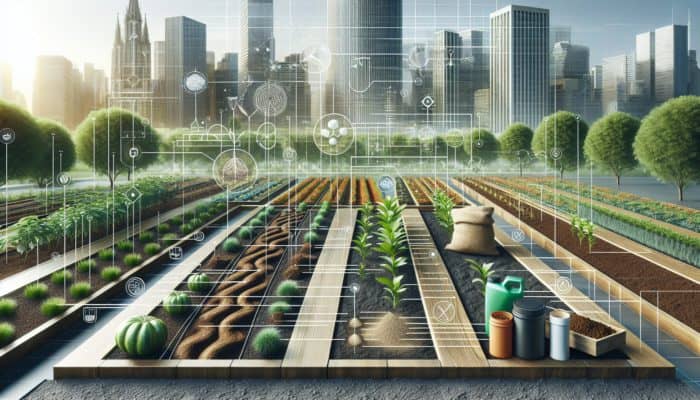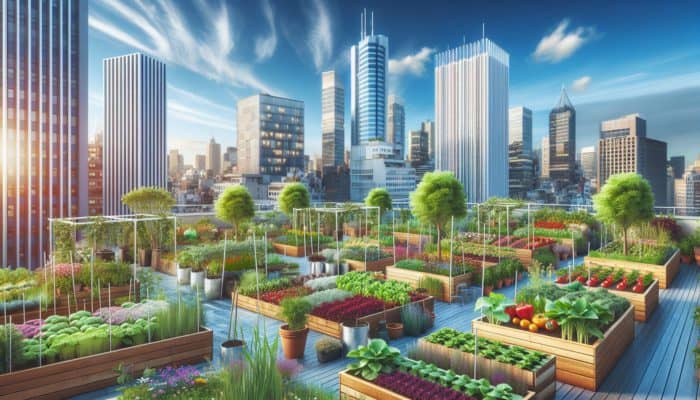Key Strategies for Successful Urban Gardening
Mastering Soil Management in Urban Settings

Urban Gardening Survival: Effectively maintaining healthy soil is paramount for achieving success in any urban garden, particularly when space is limited. Urban settings often present distinct challenges, including compacted soil and a scarcity of organic matter. Gaining a comprehensive understanding of how to manage your soil can dramatically improve your gardening outcomes. Begin by conducting a soil test to determine pH levels and nutrient content, and make adjustments as needed with compost or organic fertilizers. Regularly enriching your soil with organic materials enhances its structure, promoting better drainage and aeration.
Crucial techniques for managing soil health in urban gardens include:
- Composting: Establish compost bins or utilise community composting services to recycle organic waste.
- Mulching: Spread a layer of mulch to retain moisture and suppress weeds.
- Crop rotation: Rotate plant families each season to avert nutrient depletion.
- Raised beds: Incorporate raised beds to enhance soil structure and drainage, particularly in compacted urban soils.
- Soil amendments: Regularly introduce organic matter, such as compost or well-rotted manure, to enrich the soil.
- Cover cropping: Plant cover crops during off-seasons to prevent erosion and enhance soil fertility.
- Microbial inoculants: Introduce beneficial microorganisms to boost soil health and promote plant growth.
- Minimal tillage: Minimise disturbance to maintain soil structure and health.
Familiarising yourself with these techniques empowers urban gardeners to nurture robust plants, even within the most confined spaces.
Effective Watering Strategies for Urban Plants
Optimising watering practices is vital for urban gardening, particularly given the increasing focus on water conservation. By adopting innovative watering strategies, you can enhance water efficiency, improve plant health, and contribute to sustainable practices in urban areas. Utilising drip irrigation systems or soaker hoses facilitates targeted watering, significantly reducing evaporation and runoff. Additionally, implementing intelligent watering schedules based on weather patterns ensures that your plants receive sufficient hydration without wasting water unnecessarily.
To encourage responsible watering in urban gardens, consider the following methods:
- Drip irrigation: Install a drip system to deliver consistent moisture directly to the plant roots.
- Rain barrels: Collect rainwater to lessen reliance on municipal water supplies.
- Soil moisture sensors: Utilize sensors to determine when plants need watering, thereby preventing over- or under-watering.
- Water at dawn or dusk: Water during cooler periods to minimise evaporation and allow plants to absorb moisture effectively.
- Hydroponics: Investigate hydroponic systems that utilise less water while maximising plant growth.
- Mulching: Apply mulch to retain soil moisture and reduce the frequency of watering.
- Self-watering containers: Use containers that can autonomously maintain moisture levels.
- Companion planting: Group plants with similar water needs to optimise watering efficiency.
By integrating these strategies, urban gardeners can ensure their plants thrive while conserving vital resources.
Fundamentals of Container Gardening
Container gardening emerges as a standout solution for urban residents facing limited space or subpar soil conditions. It offers versatility in plant selection and design, enabling the cultivation of diverse plants in confined areas. The basics of container gardening begin with selecting suitable containers that provide adequate drainage and are the right size for the plants you wish to grow. Opt for pots constructed from materials such as clay, plastic, or wood, each presenting unique advantages.
Successfully maintaining a container garden necessitates understanding several key components:
- Drainage: Ensure containers possess drainage holes to avert waterlogging and root rot.
- Soil mix: Utilise a high-quality potting mix specifically formulated for container gardening.
- Fertilization: Regularly nourish container plants with a balanced fertiliser to support vigorous growth.
- Placement: Position containers in a location that receives adequate sunlight, taking into account the specific needs of the plants.
- Watering: Check moisture levels frequently; container plants typically require more water than in-ground plants.
- Rotation: Rotate plants or adjust container arrangements to maximise sunlight exposure.
- Seasonal considerations: Be aware of seasonal changes; some containers may need to be relocated indoors during winter.
- Companion planting: Combine plants that provide mutual benefits to enhance growth and pest resistance.
By mastering these container gardening fundamentals, urban gardeners can cultivate vibrant green spaces, even in the most constrained environments.
Insights from Experts on Thriving in Urban Gardening

Showcase Successful Urban Garden Examples
Numerous success stories in urban gardening can be found worldwide, highlighting the ingenuity and resilience of urban gardeners. Cities like Havana in Cuba, Detroit in the USA, and Tokyo in Japan exemplify that with determination and innovative thinking, urban gardens can flourish even in challenging conditions. These initiatives not only enhance access to fresh produce but also cultivate community spirit and encourage self-sufficiency.
Common success factors observed in these urban gardens include:
- Community involvement: Engaging residents ensures widespread support and participation.
- Adaptability: Successful gardens adjust to their unique urban environments and challenges.
- Education: Offering training and resources empowers community members to engage in gardening.
- Collaboration: Partnering with local organisations enriches resource availability and expertise.
- Resourcefulness: Utilising recycled materials and local resources lowers costs and environmental impact.
- Long-term vision: Establishing sustainable practices is crucial for the longevity of urban gardens.
- Innovative design: Creative uses of space and gardening techniques maximise productivity.
- Advocacy: Promoting the advantages of urban gardening attracts public and governmental support.
These real-world examples demonstrate that successful urban gardening projects can have a profound impact on communities, transforming bustling cities into vibrant green oases.
Actionable Steps for Launching an Urban Garden
Embarking on an urban gardening journey may seem intimidating, but breaking it down into manageable steps makes it achievable for anyone interested in growing plants in a city environment. Begin by evaluating your available space, be it a balcony, rooftop, or small yard. Understanding the conditions of your surroundings—such as sunlight, wind exposure, and access to water—will guide your plant selections.
Here’s a practical step-by-step guide to kick-starting your urban garden:
- Define your goals: Determine what you wish to cultivate—be it herbs, vegetables, or flowers—and clarify your primary objectives.
- Choose your space: Identify suitable locations that receive adequate sunlight and have access to water.
- Select containers: If utilising pots, choose sizes that are appropriate for the plants you plan to cultivate.
- Gather supplies: Collect soil, seeds, or seedlings, along with tools such as shovels, watering cans, and gloves.
- Prepare the site: Clear the area; remove debris, rocks, and weeds to create an ideal planting environment.
- Plant your seeds: Follow the specific planting guidelines for each plant type, including depth and spacing.
- Water and care: Establish a watering schedule and closely monitor plant health, adjusting care as necessary.
- Engage with your community: Share your progress and seek advice from fellow urban gardeners to foster connections.
By implementing these actionable steps, you can confidently embark on your urban gardening journey, creating a flourishing green space that benefits both you and your community.
Expert Analysis on Urban Gardening Challenges

Urban gardening comes with a unique set of challenges that can deter many aspiring gardeners. Common obstacles include limited space, poor soil quality, water restrictions, and pest management dilemmas. Understanding these hurdles enables gardeners to devise strategic solutions that ensure fruitful gardening efforts.
Addressing these challenges begins with awareness and proactive planning. For instance, limited space can be effectively managed through vertical gardening techniques, optimising every square foot available. Poor soil quality may necessitate intensive soil management practices, such as raised beds or container gardening, to improve soil quality. Water restrictions necessitate efficient watering methods, such as drip irrigation or rainwater harvesting.
Challenges often faced by urban gardeners include:
- Insufficient sunlight: Identify sun patterns and select plants suited for partial shade or consider using grow lights.
- Limited space: Incorporate vertical gardening or rooftop gardens to maximise available growing areas.
- Pest pressures: Implement integrated pest management strategies that employ natural predators and organic repellents.
- Soil contamination: Conduct soil tests and consider raised beds filled with clean soil for safety.
- Access to water: Utilise rainwater harvesting systems and efficient irrigation methods to alleviate scarcity.
- Community regulations: Familiarise yourself with local gardening laws and restrictions to ensure compliance.
- Seasonal limitations: Use cold frames or greenhouses to extend the growing season in urban settings.
- Resource availability: Leverage local gardening networks for shared tools, knowledge, and resources.
By recognising these challenges and implementing expert recommendations, urban gardeners can transform potential setbacks into opportunities for innovation and success.
Exploring the Impact of Urban Gardening on Local Communities
Urban gardening has a significant influence that extends beyond individual benefits; it plays a crucial role in strengthening local communities. Urban gardens serve as vibrant green spaces that foster community engagement, offer educational opportunities, and promote social cohesion. They transform neglected areas into thriving ecosystems, improving the quality of life for residents.
Urban gardens serve as social hubs where community members come together, share knowledge, and cultivate relationships. These spaces often function as educational platforms, teaching individuals about sustainable practices, nutrition, and food security. They also provide access to fresh produce, which is especially crucial in food deserts—urban areas with limited access to affordable and nutritious food.
Key impacts of urban gardening on communities include:
- Community empowerment: Urban gardens equip residents with the resources and knowledge to take charge of their food systems.
- Social connections: Gardens foster relationships among neighbours, strengthening community bonds.
- Educational opportunities: They serve as outdoor classrooms for schools, promoting hands-on learning about the environment and nutrition.
- Improved well-being: Access to green spaces contributes to mental health and physical activity.
- Food security: Urban gardens provide fresh produce, reducing reliance on grocery stores.
- Environmental benefits: They enhance local biodiversity and promote sustainable practices within urban settings.
- Economic opportunities: Urban gardens can generate local jobs and stimulate the economy through the sale of produce.
- Artistic expression: Many gardens incorporate art, enriching the visual landscape of urban areas.
By harnessing the power of urban gardening, communities can create resilient, sustainable environments that benefit all residents.
Highlighting Innovative Urban Gardening Techniques and Technologies
Innovation in urban gardening is vital for overcoming the challenges posed by limited space and resources. A plethora of cutting-edge techniques and technologies have emerged, enhancing the efficiency and sustainability of urban gardening practices. These advancements enable greater productivity, reduced environmental impact, and increased accessibility.
One remarkable innovative technique is vertical gardening, which utilises vertical space to cultivate plants in urban settings. This method not only maximises limited ground space but also enriches aesthetics, contributing to urban beautification. Hydroponics and aquaponics systems offer soil-less growing methods that consume significantly less water than traditional gardening, making them suitable for areas facing water scarcity.
Additional innovative approaches include:
- Smart gardening technology: Utilise applications and devices that monitor plant health, soil moisture, and weather conditions.
- Community-supported agriculture (CSA): Engage residents through subscription models that deliver fresh produce directly from urban farms.
- Permaculture principles: Implement sustainable design practices that harmonise with natural ecosystems to create self-sustaining gardens.
- Mobile gardening units: Utilize portable gardens or planter boxes that can be easily relocated to accommodate changes in sunlight or other environmental conditions.
- Urban beekeeping: Integrate beekeeping into urban gardens to support pollination and enhance local biodiversity.
- Soil-less growing systems: Explore aeroponics and other techniques that require minimal water and space.
- Green roofs: Install gardens on rooftops to improve insulation and reduce stormwater runoff.
- Neighborhood seed banks: Create local repositories for seeds to promote biodiversity and resilience in urban gardening.
By embracing these innovative techniques and technologies, urban gardeners can significantly enhance their gardening experiences and contribute to the creation of sustainable urban environments.
How Can Urban Gardening Enhance Your Health?
Exploring the Physical Health Benefits of Gardening
Participating in urban gardening offers a wealth of physical health benefits that extend beyond simply enjoying fresh produce. Gardening activities, including digging, planting, and weeding, serve as excellent forms of exercise that can enhance overall fitness and well-being. Regular participation in these activities can help reduce the risk of chronic diseases, improve cardiovascular health, and support weight management.
Gardening also promotes physical activity that incorporates strength, flexibility, and endurance. These activities can be particularly beneficial for individuals seeking enjoyable ways to integrate movement into their daily routines. Furthermore, the act of growing food can motivate individuals to embrace healthier eating habits, as readily available homegrown produce encourages a more significant intake of fruits and vegetables.
Key physical health benefits of gardening include:
- Increased physical activity: Gardening activities offer an enjoyable way to incorporate exercise into your daily routine.
- Improved cardiovascular health: Regular gardening has been linked to lower blood pressure and improved heart health.
- Muscle strengthening: Activities such as lifting, digging, and bending build muscle strength while improving overall fitness.
- Enhanced motor skills: Gardening necessitates coordination and fine motor skills, promoting physical dexterity.
- Weight management: Engaging in routine gardening helps burn calories and maintain a healthy weight.
- Exposure to fresh air: Spending time outdoors enhances respiratory health and boosts vitamin D levels.
- Reduced risk of chronic illness: Engaging in active gardening can lower the likelihood of developing obesity, diabetes, and heart disease.
- Healthy eating habits: Growing your own fruits and vegetables encourages a nutrient-rich diet.
Urban gardening serves as a multifaceted approach to improving physical health while fostering a sustainable lifestyle.
Mental Health Benefits of Access to Green Spaces
Engaging with nature yields profound psychological benefits, especially in urban environments where green spaces are scarce. Urban gardening offers a unique opportunity to connect with nature, promoting mental well-being and stress relief. Several studies suggest that spending time in green spaces can help reduce anxiety, increase feelings of happiness, and improve overall life satisfaction.
Gardening can serve as a form of mindfulness practice, enabling individuals to focus on the present moment while nurturing plants. The act of caring for living things fosters a sense of accomplishment and purpose, which positively contributes to mental health. Additionally, building community connections through gardening can alleviate feelings of isolation and loneliness.
Key mental health benefits of urban gardening include:
- Stress reduction: Gardening activities can help lower cortisol levels, contributing to a reduction in stress and anxiety.
- Enhanced mood: Interacting with plants and nature boosts feelings of happiness and contentment.
- Mindfulness: Engaging in gardening fosters a state of mindfulness, promoting present-moment awareness.
- Social connections: Community gardening nurtures relationships, diminishing feelings of isolation and loneliness.
- Sense of achievement: Successfully growing plants provides a tangible sense of accomplishment, enhancing self-esteem.
- Creativity boost: Garden design and planning stimulate creativity and problem-solving skills.
- Nature exposure: Access to green spaces correlates with lower rates of depression and anxiety.
- Improved cognitive function: Spending time in nature can enhance focus and cognitive capabilities.
By integrating urban gardening into your lifestyle, you can reap the mental health benefits associated with connecting with nature and fostering community bonds.
Nutritional Benefits from Homegrown Produce
Urban gardening not only provides physical and mental health benefits but also enhances nutrition by granting access to fresh, homegrown produce. Cultivating fruits and vegetables at home encourages healthier eating habits and increases the intake of nutrient-rich foods. Homegrown produce frequently offers superior freshness and flavour compared to store-bought alternatives, leading to greater enjoyment and satisfaction.
Moreover, urban gardening empowers individuals to make informed choices about their food sources and dietary preferences. By growing a diverse range of plants, gardeners can tailor their gardens to meet their nutritional needs and tastes. This practice promotes self-sufficiency and can help reduce food insecurity within urban populations.
Key nutritional benefits of urban gardening include:
- Access to fresh produce: Homegrown fruits and vegetables deliver superior freshness and nutrient density.
- Increased variety: Cultivating a diverse array of plants promotes a varied diet rich in essential nutrients.
- Reduced reliance on processed foods: Gardening encourages the consumption of whole, unprocessed foods.
- Organic options: Home gardens offer the chance to grow food without synthetic fertilisers and pesticides.
- Flavor enhancement: Freshly harvested vegetables often taste better than store-bought alternatives.
- Education on nutrition: Gardening imparts valuable lessons about healthy eating and food preparation.
- Cost savings: Growing your own produce can reduce grocery expenses and enhance food security.
- Empowerment: Taking control of your food sources fosters a sense of self-sufficiency and personal agency.
By embracing urban gardening, individuals can enjoy the nutritional benefits of fresh produce while cultivating a deeper connection to their food sources.
Sustainable Practices for Urban Gardening
Composting Techniques for City Dwellers
Composting is a foundational practice for sustainable urban gardening, enabling city residents to recycle organic waste and enrich their soil. In densely populated areas, where waste disposal can be challenging, composting transforms kitchen scraps and yard waste into valuable nutrients for plants. Implementing effective composting techniques can significantly enhance soil health and contribute to efforts aimed at reducing waste.
Starting a compost bin in an urban environment involves selecting appropriate materials and maintaining a balanced compost pile. Ideal compost ingredients consist of green materials (nitrogen-rich items such as fruit scraps and grass clippings) and brown materials (carbon-rich items like dried leaves and cardboard). Maintaining the right balance between these components is crucial for successful composting.
Key composting techniques for city dwellers include:
- Bin selection: Opt for a compost bin that fits your space—options include tumblers, stackable bins, or DIY containers.
- Layering: Alternate layers of green and brown materials to maintain a healthy balance.
- Aeration: Turn the compost regularly to aerate and accelerate the decomposition process.
- Moisture control: Keep the compost pile moist, but not overly wet, to promote microbial activity.
- Monitoring temperature: Maintain temperatures between 130°F and 160°F (54-71°C) to facilitate efficient compost breakdown.
- Worm Composting: Utilize vermicomposting with worms to expedite the composting process and produce nutrient-rich worm castings.
- Community composting: Join or initiate a community composting initiative to share resources and collectively reduce waste.
- Finished compost usage: Utilise the finished compost to enrich your garden soil, improving plant health and productivity.
By adopting composting techniques, urban gardeners can significantly diminish waste while enhancing the sustainability of their gardening practices.
Rainwater Harvesting for Urban Gardens
Rainwater harvesting represents a sustainable practice that empowers urban gardeners to collect and utilise rainwater for their gardens. This approach reduces reliance on municipal water supplies and contributes to resource conservation, making it particularly vital in cities where water scarcity is increasingly prevalent. Implementing rainwater harvesting systems can be straightforward or complex, depending on the available resources and space.
To effectively harvest rainwater, urban gardeners can install systems such as rain barrels or cisterns. These setups capture runoff from rooftops, providing a free and sustainable source of water for irrigation. Using rainwater in your garden not only promotes conservation but also enhances overall plant health, as rainwater is typically devoid of the chemicals present in tap water.
Key steps for rainwater harvesting in urban gardens include:
- Barrel selection: Choose a rain barrel that suits your garden size and water requirements.
- Location: Position the barrel beneath a downspout to optimise water collection.
- First flush diverters: Install a diverter to prevent the initial, contaminated runoff from entering the barrel.
- Filtration: Use mesh screens to filter out debris and insects from the harvested water.
- Storage capacity: Ensure the barrel has sufficient capacity to meet your garden's watering needs.
- Watering methods: Utilise collected rainwater for irrigation, either manually or through drip systems.
- Seasonal considerations: Prepare your rainwater system for winter by draining barrels to avert freezing.
- Community engagement: Share knowledge about rainwater harvesting with neighbours to promote broader water conservation initiatives.
Through rainwater harvesting, urban gardeners can establish sustainable watering systems that support healthy plant growth while conserving this vital resource.
Eco-Friendly Pest Control Methods
Managing pests in urban gardens can pose challenges, but adopting eco-friendly pest control methods ensures plant health without compromising the environment. Chemical pesticides can have adverse effects on local ecosystems, making it essential to explore sustainable alternatives. Eco-friendly pest control emphasises prevention, natural deterrents, and biological controls to manage pests effectively.
Preventive measures include selecting pest-resistant plant varieties and nurturing healthy soil to promote vigorous plant growth. Integrated Pest Management (IPM) strategies involve monitoring pest populations and implementing targeted interventions when necessary. Introducing beneficial insects, such as ladybugs and lacewings, can also help manage pest populations naturally.
Key eco-friendly pest control methods include:
- Companion planting: Utilise plants that naturally repel pests when planted alongside susceptible species.
- Neem oil: Apply this natural pesticide derived from the neem tree to control various pests.
- Insecticidal soap: Use soap sprays to suffocate soft-bodied pests, such as aphids and spider mites.
- Beneficial insects: Introduce predatory insects to control pest populations naturally, without the use of chemicals.
- Physical barriers: Employ row covers or nets to physically block pests from reaching plants.
- DIY traps: Create traps using household items to capture specific pests, such as fruit flies or slugs.
- Herbal repellents: Use homemade sprays from herbs like mint or garlic to deter unwanted pests.
- Healthy plant care: Maintain proper watering and fertilisation to promote plant resilience against pests.
By implementing these eco-friendly pest control methods, urban gardeners can safeguard their plants while nurturing a healthy and balanced ecosystem.
Vertical Gardening Solutions
Vertical gardening provides an innovative solution for urban gardeners facing space constraints, allowing them to maximise their growing area while enhancing the aesthetics of their surroundings. By utilising vertical surfaces, gardeners can cultivate a variety of plants—from vegetables to ornamental flowers—without requiring expansive ground space. This technique not only optimises growing conditions but also contributes to urban beautification and environmental sustainability.
To create a vertical garden, various structures and systems can be employed, including wall planters, trellises, and vertical frames. These systems can be adapted to suit different spaces, from compact balconies to extensive community gardens. Successful vertical gardening relies on selecting appropriate plants that flourish in these conditions and ensuring they receive sufficient light and water.
Innovative vertical gardening solutions include:
- Wall planters: Utilize wall-mounted planters to create green walls that enhance your property's visual appeal.
- Living fences: Construct fences or screens made from climbing plants to improve privacy and aesthetics.
- Trellises: Install trellises for climbing plants; ideal for peas, beans, and cucumbers.
- Pallet gardens: Repurpose wooden pallets for vertical planting, creating artistic garden displays.
- Hanging pots: Suspend pots from ceilings or hooks to utilise overhead space effectively.
- Hydroponic towers: Utilize vertical hydroponic systems for efficient, soilless growing.
- Stackable planters: Use stackable containers to establish multi-tiered gardens in limited spaces.
- Gutter gardens: Repurpose old gutters to create long, narrow planting containers mounted on walls or fences.
By embracing vertical gardening solutions, urban gardeners can cultivate a diverse array of plants while maximising limited space and contributing to urban greening efforts.
Utilising Native Plants in Urban Gardens
Incorporating native plants into urban gardens represents a sustainable practice that significantly enhances biodiversity and ecological health. Native plants are well-adapted to local conditions, requiring less water, fertiliser, and maintenance compared to non-native species. By utilising native flora, urban gardeners can create resilient ecosystems that support local wildlife, including pollinators and beneficial insects.
Additionally, native plants frequently contribute to improving soil health and preventing erosion, making them valuable components of urban landscapes. Selecting plants that naturally thrive in the local environment ensures that gardens remain vibrant, productive, and sustainable over time.
Key benefits of using native plants in urban gardens include:
- Biodiversity enhancement: Native plants support local wildlife, contributing to healthier ecosystems.
- Low maintenance: These plants require less water and care, making them ideal for busy urban gardeners.
- Soil health improvement: Native species often enhance soil quality and structure through deep root systems.
- Climate adaptation: Native plants are naturally resilient to local climate conditions, reducing the need for intervention.
- Pest resistance: Native plants are often less susceptible to pests and diseases compared to non-native species.
- Cultural significance: Many native plants hold cultural importance and can connect communities to their heritage.
- Water conservation: Native plants typically require less irrigation, making them suitable for areas with limited water resources.
- Seasonal interest: Native plants often provide visual interest throughout various seasons, showcasing their natural beauty.
By prioritising native plants in urban gardening efforts, gardeners can contribute to sustainable practices that benefit both the environment and their communities.
What Are the Best Plants for Urban Gardening?
Selecting Vegetables for City Gardens
Choosing the right vegetables for urban gardens is crucial for ensuring successful growth and bountiful harvests. Factors such as space limitations, climate conditions, and sunlight exposure significantly influence the selection of vegetables best suited for urban environments. Opting for varieties that thrive in containers or small garden beds can maximise productivity and minimise challenges.
Popular vegetable choices for urban gardening include fast-growing and high-yielding options that provide ample rewards for limited space. Vegetables like tomatoes and peppers are particularly well-suited for containers and can thrive in small areas with adequate sunlight.
Recommended vegetables for city gardens include:
- Tomatoes: A beloved choice, tomatoes thrive in containers and yield abundant crops.
- Radishes: Quick-growing and needing minimal space, radishes can be harvested in as little as three weeks.
- Lettuce: Leafy greens like lettuce are perfect for compact spaces and can be harvested continuously.
- Herbs Such as Basil, parsley, and cilantro flourish in containers, elevating culinary dishes.
- Peppers: Both sweet and hot varieties thrive well in pots, offering a range of flavours.
- Green beans: Climbing varieties can effectively utilise vertical space and yield abundant harvests.
- Carrots: Suitable for containers, carrots grow deep in the soil, making them ideal for urban settings.
- Spinach: A nutritious option that flourishes in cooler temperatures and can be cultivated in limited space.
By thoughtfully selecting vegetables for urban gardens, gardeners can optimise their growing conditions and enjoy a productive and rewarding gardening experience.
Herbs That Thrive in Urban Settings
Herbs represent an excellent choice for urban gardening due to their versatility, compact growth habit, and culinary benefits. Growing herbs in urban environments allows gardeners to savour fresh flavours while enhancing the visual appeal of their gardens. Many herbs flourish in containers or small garden beds, making them ideal for confined spaces.
The ability to regularly harvest herbs encourages gardeners to incorporate more fresh ingredients into their meals, promoting healthier eating habits. Moreover, many herbs attract pollinators, contributing to biodiversity in urban ecosystems.
Recommended herbs for urban gardening include:
- Basil: A versatile herb that thrives in warm weather and can be grown in containers or garden beds.
- Mint: A hardy herb that grows easily, though it may require containment to prevent spreading.
- Parsley: A biennial herb that flourishes in various conditions and enhances culinary dishes.
- Thyme: This low-growing herb prefers well-drained soil and can be cultivated in small spaces.
- Cilantro: A fast-growing herb that can be harvested multiple times throughout its growing season.
- Chives: A perennial herb that adds flavour to dishes and grows well in containers.
- Oregano: A drought-tolerant herb that thrives in sunny locations and requires minimal maintenance.
- Sage: A fragrant herb that flourishes in containers and adds culinary depth to various dishes.
By cultivating these herbs in urban gardens, gardeners can enjoy the benefits of fresh, flavourful ingredients while enhancing biodiversity and sustainability.
Ornamental Plants for Urban Beautification
In addition to functional plants, incorporating ornamental plants into urban gardens not only enhances aesthetic appeal but also contributes to the overall greening of urban environments. Ornamental plants can beautify small spaces, provide shade, and create a welcoming atmosphere for both residents and visitors. Selecting the right ornamental plants is essential to ensure they thrive in urban settings and complement the surrounding landscape.
When choosing ornamental plants, consider factors such as climate, light conditions, and maintenance requirements. Plants well-suited for urban environments often possess traits such as drought resistance, pollution tolerance, and pest resistance.
Recommended ornamental plants for urban beautification include:
- Marigolds: Bright, cheerful flowers that are easy to grow and attract beneficial insects.
- Lavender: A fragrant perennial that adds beauty and attracts pollinators.
- Hydrangeas: These flowering shrubs offer stunning blooms and thrive in a wide range of conditions.
- Succulents: Low-maintenance plants that add unique textures and colours to urban gardens.
- Hostas: Shade-tolerant perennials that offer lush foliage and require minimal care.
- Ornamental grasses: These plants introduce movement and texture to gardens while being low-maintenance.
- Roses: Classic, fragrant flowers that can thrive in urban gardens with appropriate care.
- Ferns: Shade-loving plants that provide lush greenery and flourish in urban environments.
By thoughtfully incorporating ornamental plants into urban gardens, gardeners can contribute to urban beautification while enhancing their connection to nature.
Research-Backed Advantages of Urban Gardening Survival
Assessing the Impact of Urban Gardening on Community Cohesion
Urban gardening has a significant impact on community cohesion, fostering connections among residents and encouraging collective efforts toward sustainability. Gardening initiatives create opportunities for individuals to collaborate, share resources, and build friendships, ultimately strengthening the social fabric of neighbourhoods. These community-driven projects often lead to heightened engagement, empowerment, and a sense of belonging.
Research indicates that urban gardens can serve as social hubs, where community members unite to work, learn, and celebrate. They provide platforms for shared experiences, skill-building, and knowledge exchange, which are vital for cultivating strong relationships among diverse populations.
Key impacts of urban gardening on community cohesion include:
- Building relationships: Gardening promotes social interaction and helps individuals connect across cultural boundaries.
- Shared goals: Collaborating on gardening projects fosters a sense of purpose and unity, promoting a sense of shared purpose and unity.
- Resource sharing: Community gardens encourage the exchange of tools, seeds, and expertise, alleviating individual burdens.
- Empowerment: Residents gain skills and confidence through gardening, fostering leadership within the community.
- Healthier neighbourhoods: Access to fresh produce enhances community health, leading to a shared interest in well-being.
- Environmental stewardship: Engaging in gardening encourages responsible environmental practices among community members.
- Increased civic engagement: Community gardens often spur greater involvement in local governance and decision-making.
- Celebrating diversity: Shared gardening experiences highlight cultural diversity and promote inclusivity.
By harnessing the power of urban gardening to enhance community cohesion, residents can create vibrant, resilient neighbourhoods that thrive together.
Real-World Examples of Urban Gardening's Environmental Benefits
Urban gardening initiatives yield substantial environmental benefits, contributing to the sustainability and ecological health of cities worldwide. These projects enhance biodiversity, improve air quality, and mitigate the urban heat island effect. By transforming vacant lots and rooftop spaces into green oases, urban gardens promote a healthier environment for both humans and wildlife.
Cities such as Detroit in Michigan and Melbourne in Australia have successfully implemented urban gardening projects prioritising environmental sustainability. These initiatives not only provide fresh produce but also restore ecosystems and create habitats for wildlife.
Key environmental benefits of urban gardening include:
- Biodiversity enhancement: Urban gardens create habitats for pollinators and other beneficial organisms.
- Air quality improvement: Plants filter pollutants and enhance air quality in densely populated areas.
- Stormwater management: Gardens absorb rainwater, reducing runoff and minimising flooding risks.
- Carbon sequestration: Urban gardens help capture and store carbon dioxide, thereby mitigating the effects of climate change.
- Temperature regulation: Green spaces lower temperatures, reducing the urban heat island effect and energy consumption.
- Soil health restoration: Urban gardening practices improve soil quality and prevent erosion.
- Community resilience: Gardens enhance food security and promote self-sufficiency in urban areas.
- Waste reduction: Composting and recycling practices in urban gardens decrease landfill waste.
Through these real-world examples, it is evident that urban gardening initiatives contribute to a more sustainable and environmentally friendly urban landscape.
Actionable Steps for Evaluating Urban Gardening Initiatives
Measuring the success of urban gardening initiatives is essential for demonstrating their impact and sustainability. By tracking various metrics, gardeners and community organisers can evaluate progress, pinpoint areas for improvement, and advocate for ongoing support. Establishing clear goals and benchmarks is crucial for effective assessment and evaluation.
Actionable steps for measuring success in urban gardening initiatives include:
- Set specific goals: Define measurable objectives, such as increased production, community engagement, or educational outreach.
- Collect data: Regularly gather information on plant growth, harvest yields, and participant involvement.
- Surveys and feedback: Conduct surveys among participants and community members to assess satisfaction and gather feedback and suggestions.
- Monitor environmental impact: Track changes in biodiversity, soil health, and air quality resulting from gardening initiatives.
- Document progress: Maintain records of gardening activities, challenges faced, and lessons learned throughout the growing season.
- Community participation: Involve community members in evaluation processes to ensure diverse perspectives are considered.
- Celebrate successes: Highlight achievements and milestones to inspire continued participation and support.
- Adjust strategies: Utilize gathered data to inform decisions and refine gardening practices for future success.
By implementing these actionable steps, urban gardeners can effectively measure and communicate the success of their initiatives, fostering ongoing community engagement and support.
Examining the Psychological Benefits of Urban Gardening for Individuals
Urban gardening offers numerous psychological benefits that can enhance individual well-being and quality of life. Engaging in gardening activities provides a therapeutic outlet, allowing individuals to connect with nature and experience the calming effects of nurturing plants. Research suggests that spending time in green spaces can help alleviate stress, promote relaxation, and enhance overall mental well-being.
Gardening fosters a sense of accomplishment and purpose as individuals witness the fruits of their labour. This tangible connection to nature can enhance feelings of self-worth and promote mindfulness, allowing individuals to focus on the present moment and escape daily stresses.
Key psychological benefits of urban gardening include:
- Stress relief: Gardening activities can lower stress levels and promote relaxation through physical engagement.
- Mindfulness: Connecting with plants encourages present-moment awareness, fostering a sense of calm.
- Improved mood: Interacting with nature and observing plant growth can lead to increased feelings of happiness and satisfaction.
- Social interaction: Community gardening nurtures relationships, reducing feelings of isolation and loneliness.
- Creative expression: Gardening provides opportunities for creativity and self-expression through design and plant selection.
- Enhanced self-esteem: Successfully nurturing plants boosts confidence and provides a sense of achievement.
- Connection to nature: Spending time in green spaces fosters appreciation for the environment and encourages sustainability.
- Resilience building: Overcoming gardening challenges can enhance problem-solving skills and personal resilience.
By embracing urban gardening, individuals can cultivate not only plants but also improved mental well-being and emotional health.
Evaluating the Economic Advantages of Urban Gardening in Urban Settings
Urban gardening initiatives offer substantial economic advantages that can benefit both individuals and communities. These projects can lead to cost savings, job creation, and increased property values, creating a positive ripple effect within urban areas. By investing in urban gardens, cities can promote economic resilience and sustainability, while also enhancing the quality of life for their residents.
One of the most tangible economic benefits of urban gardening is the reduction in food costs. Growing fresh produce at home decreases reliance on grocery stores and allows individuals to save money on groceries. Furthermore, community gardens can provide access to affordable, nutritious food for low-income neighbourhoods, addressing food insecurity.
Key economic advantages of urban gardening include:
- Cost savings: Growing your own food reduces grocery expenses and enhances food security.
- Job creation: Urban gardening initiatives can generate jobs in landscaping, gardening education, and food production.
- Increased property values: Well-maintained gardens enhance neighbourhood aesthetics and can raise property values.
- Local economies: Urban gardens can stimulate local economies through farmers' markets and community-supported agriculture.
- Green jobs: Promoting gardening initiatives can lead to the development of green jobs in urban agriculture.
- Community engagement: Urban gardens foster entrepreneurship and skill development among community members.
- Environmental cost savings: Increased green space can reduce urban infrastructure costs, including those associated with stormwater management.
- Investment in public health: Improved access to fresh produce contributes to better health outcomes, reducing healthcare costs.
By exploring the economic advantages of urban gardening, communities can recognise the potential for sustainable growth and enhanced individual prosperity.
How to Maximise Space in Urban Gardening?
Vertical Gardening Techniques
Maximising available space is crucial for successful urban gardening, especially in densely populated areas. Vertical gardening provides an innovative solution, allowing gardeners to utilise vertical surfaces for growing plants. By implementing vertical gardening techniques, urban gardeners can create lush, productive spaces while enhancing the aesthetics of their surroundings.
To effectively implement vertical gardening, consider various structures and systems that support plant growth while maximising limited ground space. These solutions are especially advantageous for small balconies, courtyards, or community garden plots.
Practical vertical gardening solutions include:
- Wall-mounted planters: Use wall planters to create green walls that occupy minimal ground space.
- Trellises and arbors: Install these structures to support climbing plants and utilise vertical height.
- Hanging baskets: Suspend baskets from ceilings or hooks to optimise overhead space and add visual interest.
- Living fences: Use climbing plants to create natural barriers that enhance privacy and aesthetics.
- Stacked planters: Utilise tiered systems to allow multiple levels of planting in small areas.
- Gutter gardens: Repurpose old gutters as planters mounted vertically to grow herbs or small vegetables.
- Vertical hydroponic systems: Implement hydroponic towers that utilise less water and soil while maximising growing space.
- Pallet gardens: Use wooden pallets to create vertical planting surfaces for herbs and flowers.
By adopting these vertical gardening solutions, urban gardeners can effectively maximise their growing spaces and cultivate a diverse array of plants.
Rooftop Gardening Techniques
Rooftop gardening offers a unique opportunity for urban gardeners to maximise space while contributing to green infrastructure. Rooftop gardens can transform unused or underutilised spaces into productive, vibrant environments that benefit both the gardener and the surrounding community. However, rooftop gardening requires careful planning and consideration of structural aspects to ensure safety and sustainability.
Key techniques for successful rooftop gardening include assessing the roof's load-bearing capacity, selecting suitable plants, and implementing an efficient watering system. It’s essential to create a well-draining garden system that minimises water retention and prevents structural damage.
Practical rooftop gardening techniques include:
- Weight considerations: Ensure the rooftop can support the weight of soil, plants, and water.
- Container gardening: Use lightweight containers to reduce overall weight while maximising planting options.
- Drainage systems: Implement proper drainage solutions to prevent water accumulation and structural damage.
- Soil selection: Use lightweight, high-quality potting mixes specifically designed for rooftop gardens.
- Microclimate assessment: Consider wind exposure and sunlight when placing plants to optimise growth conditions.
- Watering systems: Utilise drip irrigation or self-watering systems to efficiently manage water usage.
- Access pathways: Design pathways to ensure easy access for maintenance and harvesting without damaging plants.
- Permaculture principles: Implement sustainable practices that enhance biodiversity and promote environmental health.
By adopting these rooftop gardening techniques, urban gardeners can effectively transform rooftops into productive green spaces that benefit both individuals and the community.
Innovations for Small Space Gardening
Innovative approaches to small-space gardening are essential for urban gardeners looking to maximize productivity in constrained areas. Creative strategies can significantly enhance the ability to grow a variety of plants, even in the smallest of spaces. These innovations often focus on utilising vertical structures, efficient container designs, and novel growing techniques.
Emphasising space-saving techniques enables urban gardeners to cultivate fruits, vegetables, and ornamental plants within confined areas, such as balconies, patios, or small yards. Many of these innovations promote sustainability and encourage the selection of diverse plants.
Innovative methods for small space gardening include:
- Container gardening: Use various container types, including vertical planters, to maximise space and grow multiple plants.
- Stackable planters: Employ tiered planter systems to create multi-level gardens in small areas.
- Square foot gardening: Utilize grid techniques to plan and organize planting efficiently, optimizing every square foot.
- Hydroponics or aquaponics: Implement soil-less growing methods that conserve space and water while maximising yield.
- Intercropping: Combine compatible plants in the same space to utilise resources efficiently and improve yields.
- Vertical trellising: Utilize vertical supports for climbing plants to conserve ground space and boost productivity.
- Recycled materials: Repurpose items like old pallets or crates as planting containers to minimise waste and cost.
- Community gardens: Engage in shared gardening spaces that allow for the cultivation of diverse plants without requiring extensive individual space.
By leveraging these small space gardening innovations, urban gardeners can create thriving gardens that contribute to sustainability and enhance the beauty of urban landscapes.
Trusted Strategies for Thriving in Urban Gardening
Expert Analysis on the Economic Benefits of Urban Gardening
Urban gardening presents numerous economic benefits that extend beyond individual gardening efforts, contributing to community prosperity and resilience. By promoting local food production, urban gardens can lower food costs and enhance access to fresh produce. This, in turn, enhances food security and supports the overall health of urban populations.
Moreover, urban gardening initiatives can create job opportunities in gardening, landscaping, and sustainable agriculture, stimulating local economies. Community gardens often serve as platforms for entrepreneurial ventures, such as farmers’ markets or small-scale food businesses, further boosting economic growth.
Key economic benefits of urban gardening include:
- Local food production: Urban gardens provide fresh produce, reducing reliance on distant suppliers and promoting local economies.
- Job creation: Gardening initiatives can generate jobs in urban agriculture, education, and related fields.
- Cost savings: Growing food at home lowers grocery bills and food expenses for urban residents.
- Increased property values: Well-maintained gardens contribute to neighbourhood aesthetics and can raise property values.
- Community development: Urban gardens promote collaboration and resource sharing among residents, strengthening community ties.
- Promoting entrepreneurship: Gardens can serve as incubators for local food businesses and innovative agricultural practices.
- Public health cost savings: Improved access to fresh produce can lead to better health outcomes and reduced healthcare costs.
- Sustainable practices: Urban gardening promotes environmental sustainability, leading to long-term economic benefits for communities.
By understanding the economic benefits of urban gardening, communities can recognise the potential for growth, resilience, and enhanced overall well-being.
Examples of Urban Gardening in Educational Settings
Integrating urban gardening into educational settings offers valuable learning experiences that transcend traditional classroom boundaries. Schools and educational institutions worldwide have embraced gardening initiatives to teach students about sustainability, nutrition, and environmental stewardship. These programs foster hands-on learning, encouraging students to develop a deeper understanding of where their food comes from and the importance of caring for the environment.
Real-world examples of successful urban gardening initiatives in educational settings highlight their positive impact on student engagement and community involvement. Schools that incorporate gardening into their curricula often witness improved academic performance, heightened interest in science, and enhanced social skills.
Key examples of urban gardening in educational settings include:
- School gardens: Many schools have established gardens to teach students about food production, ecology, and nutrition.
- Community partnerships: Collaborations with local organisations provide resources and expertise for school gardening initiatives.
- Curriculum integration: Schools integrate gardening into subjects like science, math, and health, promoting interdisciplinary learning.
- Student-led initiatives: Empowering students to lead gardening projects fosters leadership skills and a sense of responsibility.
- Garden-to-table programs: Schools incorporate harvested produce into cafeterias, enhancing student awareness of healthy eating.
- Environmental education: School gardens serve as outdoor classrooms for teaching sustainability and environmental science.
- Parent and community involvement: Engaging families in gardening activities strengthens community ties and support.
- Workshops and events: Schools host workshops to educate families and the community about gardening and nutrition.
By incorporating urban gardening into educational settings, schools can create enriching experiences that foster a love for nature and healthy living.
Actionable Steps for Integrating Urban Gardening into Daily Life
Incorporating urban gardening into daily life can enhance personal well-being, promote sustainability, and foster community engagement. By making small changes and incorporating gardening practices into everyday routines, individuals can reap the numerous benefits of cultivating plants and growing their own food.
Actionable steps for integrating urban gardening into daily life include:
- Start small: Begin with a few pots or a small garden bed to ease into gardening without overwhelming yourself.
- Commit to daily time: Dedicate a few minutes each day to garden maintenance, such as watering or weeding.
- Plan your garden: Develop a planting plan that considers available space, sunlight, and desired plants.
- Join a community garden: Connect with local gardeners to share resources, knowledge, and support.
- Educate yourself: Attend workshops or read books on gardening techniques and best practices to enhance your knowledge.
- Involve family and friends: Engage loved ones in gardening activities to foster a sense of community and collaboration.
- Use social media: Share your gardening experiences online to inspire and connect with others.
- Celebrate successes: Acknowledge achievements, whether big or small, to maintain motivation and enthusiasm for gardening.
By following these actionable steps, individuals can seamlessly incorporate urban gardening into their daily lives, creating a positive impact on their health and the environment.
Discussing the Environmental Impact of Urban Gardening
Urban gardening has a profound environmental impact, contributing to sustainability and ecological health in urban areas. By transforming vacant lots and underutilized spaces into green oases, urban gardens enhance biodiversity, improve air quality, and mitigate the effects of climate change. These gardens not only provide fresh produce but also create habitats for wildlife, promoting a sense of stewardship for the environment.
Research has shown that urban gardens can significantly reduce the urban heat island effect by providing shade and increasing evapotranspiration. This cooling effect can help lower energy consumption and improve overall urban livability. Additionally, green spaces have been linked to improved mental health and well-being among residents, creating a positive feedback loop that fosters community engagement and environmental responsibility.
Key environmental impacts of urban gardening include:
- Biodiversity enhancement: Urban gardens create habitats for pollinators, beneficial insects, and other wildlife.
- Air quality improvement: Plants help filter pollutants from the air, contributing to better air quality for urban residents.
- Stormwater management: Gardens absorb rainwater, reducing runoff and minimising flooding risks.
- Improving soil health: Urban gardening practices enhance soil quality and contribute to local food production.
- Carbon sequestration: Urban gardens capture carbon dioxide, helping mitigate climate change.
- Temperature regulation: Green spaces help cool urban areas, reducing reliance on air conditioning.
- Waste reduction: Composting and recycling practices in urban gardens decrease landfill waste and pollution.
- Community resilience: Urban gardening promotes self-sufficiency and local food production, enhancing community resilience to economic challenges.
By recognising the environmental impact of urban gardening, communities can leverage these benefits to create sustainable and thriving urban landscapes.
Highlighting the Community-Building Aspects of Urban Gardening
Urban gardening serves as a powerful tool for community building, fostering connections among residents and promoting collective action toward sustainability. By creating shared green spaces, urban gardens encourage collaboration, social interaction, and a sense of belonging. These communal efforts can lead to strengthened neighbourhood ties, increased civic engagement, and a shared commitment to environmental stewardship.
Gardening initiatives often unite individuals from diverse backgrounds and cultures, promoting inclusivity and understanding. Collaborative gardening projects foster teamwork and encourage the sharing of skills, resources, and knowledge. Additionally, urban gardens can act as venues for community events, workshops, and celebrations, further enhancing social connections.
Key community-building aspects of urban gardening include:
- Collaboration: Urban gardens encourage teamwork among residents, promoting a sense of shared purpose.
- Social interaction: Gardening projects create opportunities for individuals to connect and build relationships.
- Community leadership: Residents often take on leadership roles in gardening initiatives, fostering a sense of empowerment and community engagement.
- Inclusivity: Urban gardens welcome individuals from diverse backgrounds, highlighting cultural richness.
- Resource sharing: Community gardens facilitate the exchange of tools, seeds, and knowledge among gardeners.
- Event organisation: Urban gardens serve as venues for community gatherings, workshops, and social events.
- Collective learning: Residents learn from each other, sharing gardening techniques and sustainability practices.
- Celebration of diversity: Community gardens often reflect the cultural diversity of the neighbourhood through plant selections and gardening practices.
By harnessing the community-building potential of urban gardening, neighbourhoods can cultivate stronger, more resilient communities that thrive together.
Community Involvement in Urban Gardening
Establishing Urban Gardening Networks
Creating urban gardening networks is essential for connecting aspiring gardeners, sharing resources, and building community resilience. These networks create platforms for collaboration and knowledge exchange, fostering a sense of belonging among urban gardeners. By connecting with local organisations, community groups, and gardening enthusiasts, individuals can access valuable support and resources that enhance their gardening experiences.
To build effective urban gardening networks, consider the following approaches:
- Join local gardening groups: Participate in community gardening organisations to meet fellow gardeners and share experiences.
- Organise workshops: Host gardening workshops to educate community members on gardening techniques and sustainability practices.
- Participate in events: Attend local gardening events and fairs to connect with other gardeners and learn from experts.
- Share resources: Develop a resource-sharing system that allows gardeners to exchange tools, seeds, and knowledge.
- Utilise social media: Create online platforms or groups to facilitate communication and support among urban gardeners.
- Engage youth: Encourage young people to participate in gardening initiatives, helping to foster a new generation of gardeners.
- Collaborate with local businesses: Partner with local shops to support gardening projects and promote community initiatives.
- Advocate for policies: Work with local officials to promote policies that support urban gardening and green spaces.
By establishing urban gardening networks, communities can cultivate a supportive environment that encourages collaboration, knowledge sharing, and collective growth.
Solar Generator Reviews: Your Ultimate Guide
Comprehensive Guide to Solar Generators What Exactly Are Solar Generators? Solar Generator Reviews: Solar generators are cutting-edge technology designed to capture and convert sunlight into usable electricity effectively. These remarkable devices comprise solar panels that absorb sunlight, batteries that store the converted energy, and an inverter that converts the stored direct current (DC) electricity into […]
Wildfire Defensible Space: Protecting Your Home
Crafting Effective Wildfire Defensible Space for Your Home What Is the Concept of Wildfire Defensible Space? Wildfire Defensible Space: A carefully managed, strategically designed area surrounding homes and properties designed to reduce the risk of fire damage significantly. This critical concept is essential for safeguarding structures, particularly in regions vulnerable to wildfires. Establishing defensible space is […]
Water Filter Comparisons: Your Ultimate Guide
Comprehensive Overview of Water Filter Types Understanding Reverse Osmosis Systems for Optimal Water Purity Water Filter Comparisons: Reverse osmosis (RO) systems are among the most sophisticated technologies available for water filtration. By employing a semipermeable membrane, these systems effectively eliminate a wide range of contaminants, including salts, heavy metals, and microorganisms. The filtration process involves […]
Water Collection Systems: Essential Solutions for Sustainability
Comprehensive Overview of Water Collection Systems What Exactly Are Water Collection Systems? Water Collection Systems: Water collection systems encompass a variety of innovative technologies and methodologies specifically developed to capture, store, and utilise water from diverse sources, with a primary focus on rainwater. These systems are crucial for the sustainable management of water resources, particularly in […]








I really appreciate how you’ve highlighted the significance of soil management in urban gardening—it’s something that often gets overlooked. Having grown my own little container garden on a small balcony, I can definitely relate to the struggles of dealing with compacted soil and limited organic matter. It’s fascinating how even the tiniest changes in soil quality can make such a difference in plant health and yield.
It’s great to hear about your experience with container gardening. Compact soil can be such a challenge, especially when space is limited. One thing I’ve found helpful is incorporating materials like coco coir or perlite to improve drainage and aeration in those tight spaces. It can make a surprising difference in how the plants respond.
“I’m so glad to hear you relate to the challenges of urban gardening! If you’re looking for tips on improving your soil quality and boosting your garden’s potential, check out this resource that could make a real difference.”
https://survivalbite.com/wild